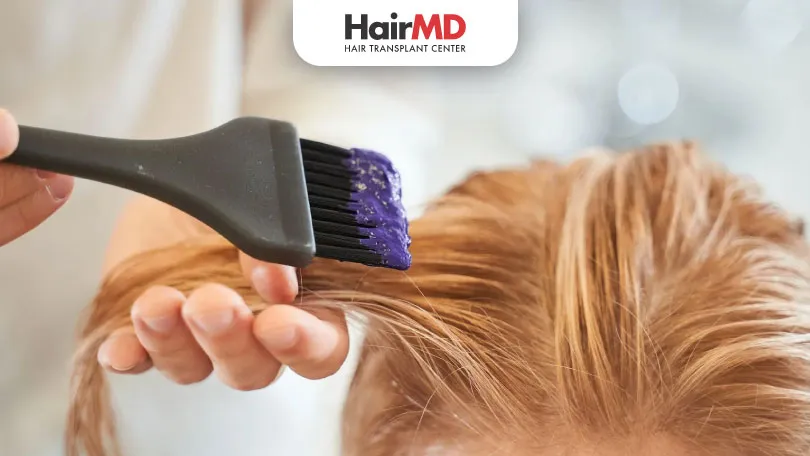28th Oct, 2022

Many of us enjoy the exciting transformation that hair coloring offers, but it often brings along concerns about damage. Does using hair dye lead to hair loss, or is it mostly about hair breakage? These worries can be confusing, so let’s take a closer look.
In this blog, we will explore the relationship between hair dye and hair health. Plus, we’ll share some helpful tips for coloring your hair while keeping it healthy and strong. Join us on this journey to discover how to enjoy vibrant hair color without compromising its quality!
What’s covered in the article?
- Hair Coloring and Its Impact
- What Happens During the Hair Coloring Process?
- Chemicals Involved in Hair Coloring
- The Reality of Hair Loss vs. Hair Breakage
- How Does Hair Coloring Lead to Breakage?
- Minimizing Hair Damage from Coloring
- Long-Term Health and Vibrancy of Colored Hair
- Conclusion
Hair Coloring and Its Impact
Hair colouring is not just a beauty routine; it’s a complex chemical process that alters the structure of your hair. Whether you’re opting for permanent, semi-permanent, or demi-permanent colour, the basic principle involves penetrating the hair’s cuticle to deposit colour. This process requires chemicals that can potentially weaken the hair if not handled correctly.
क्या Hair Colouring से Hair Loss होता है ? | Dr Dhanraj Chavan | HairMD Pune
What Happens During the Hair Coloring Process?
The typical hair dyeing procedure involves several chemical reactions, starting with the use of ammonia to open up the hair cuticle. Following this, a developer, usually containing hydrogen peroxide, removes the natural pigment from your hair, making space for the new colour. The coloring agents then deposit the new pigments, which are locked in when the cuticle reseals. This process, while effective in changing hair colour, can leave the hair vulnerable to damage.
Chemicals Involved in Hair Coloring
Key chemicals in hair dyes include:
- Ammonia: Opens the cuticle layer, allowing colour molecules to penetrate the hair shaft.
- Peroxide: Removes existing hair colour to make way for the new shade.
- Coloring Agents: Various compounds that provide the actual colour.
Each of these chemicals has a specific role, but their combined effect can stress the hair, leading to increased porosity and fragility.
The Reality of Hair Loss vs. Hair Breakage
When discussing hair issues, it’s essential to distinguish between hair loss and hair breakage, as they stem from different causes and affect your hair in different ways. Hair loss, or alopecia, refers to the actual shedding of hair from the scalp, where the hair comes out from the root. Often, this is linked to factors beyond your immediate control, such as genetic predispositions, hormonal imbalances, or other underlying health conditions that might disrupt the natural growth cycle of hair follicles.
On the other hand, hair breakage is about the structural integrity of the hair shaft itself becoming compromised, leading to the hair breaking off at some point along the strand, not from the root. This condition does not affect the growth cycle of the hair but impacts the length and quality of the hair. Breakage is frequently observed in individuals who subject their hair to chemical treatments like colouring, thermal styling, or even mechanical stresses such as tight braiding or excessive brushing.
How Does Hair Coloring Lead to Breakage?
Hair colouring involves chemical processes that open up the cuticle of the hair to deposit colour. The primary chemicals used, including ammonia and hydrogen peroxide, serve to lift the cuticle and strip away natural pigments, preparing the hair for new colour. While effective for changing hair colour, these chemicals can also weaken the hair.
The opening of the cuticle is not a gentle process; it can be quite harsh, leaving the hair vulnerable to external elements and prone to breakage. Once the protective cuticle is lifted, the inner structure of the hair, primarily made of keratin proteins, is exposed. The chemical interaction during the dyeing process can lead to a breakdown of these proteins, which compromises the hair’s natural strength and elasticity.
Repeated colouring processes exacerbate this effect, as each session strips the hair further of its natural oils and proteins, making it increasingly brittle and stiff. This brittleness means that the hair is less flexible and more likely to snap under tension, such as when brushing or styling. In environments with extreme temperatures or low humidity, the risk of breakage can increase further as the hair loses moisture and becomes even more fragile.
Minimizing Hair Damage from Coloring
To enjoy the benefits of hair colouring without compromising hair health, consider the following strategies:
Choose the Right Color Products
Opt for high-quality hair dyes that contain nourishing ingredients. Ammonia-free dyes can be less damaging as they don’t swell the hair shaft as much as ammonia-based products. However, they may not last as long or cover grey hair as effectively.
Professional Application is Key
Having your hair coloured by a professional stylist can significantly reduce the risk of damage. Stylists are trained to use products correctly and can assess your hair type and condition to choose the most suitable dyeing technique and products.
Implement a Robust Aftercare Routine
Post-colouring care is crucial in maintaining hair health. Include these steps in your routine:
- Regular Conditioning: Use deep conditioners and hair masks weekly to replenish moisture and nutrients lost during colouring.
- Avoid Heat Styling: Minimize the use of heat styling tools that can further stress coloured hair.
- Protect Against Environmental Factors: Sun exposure and pollution can degrade the colour and health of your hair. Use products with UV protection and try to cover your hair when outside for extended periods.
Monitor coloring Frequency
The frequency of colouring can also impact hair health. Waiting longer between colour sessions allows your hair more time to recover and regain strength.
Long-Term Health and Vibrancy of Colored Hair
To ensure the long-term health of your coloured hair, it’s essential to understand the products and processes involved. By choosing quality dyes, limiting exposure to harsh chemicals, and maintaining a rigorous aftercare regimen, you can significantly mitigate the risks associated with hair colouring.
You can achieve a beautiful hair colour that is vibrant and long-lasting, without compromising the health of your hair. Remember, the key to maintaining healthy, coloured hair is all about how you care for your hair before, during, and after the colouring process. But if you are experiencing excessive hair fall during and after the colouring, it’s important to consult with HairMD Pune.
Do You Know?
Nearly 250 Patients Visit HairMD
Everyday For Various Hair Concerns?
(Your journey to healthier and fuller hair starts here!)
Meet Our Dermatologists
Conclusion
In conclusion, hair coloring can transform your look but may raise concerns about potential damage. Understanding the difference between hair loss and breakage is crucial. While the coloring process involves chemicals that can weaken hair, proper care and techniques can minimize damage. Choosing quality products, professional application, and a solid aftercare routine are key to maintaining vibrant, healthy hair.
If you notice excessive hair fall, don’t hesitate to reach out to our hair specialists at HairMD Pune for guidance and treatment options. Embrace your beautiful hair color while keeping your hair healthy!
Further Reading
First-Time IV Drip for Hair Growth? Here’s What to Expect?
Considering IV drip for hair growth in Pune? Discover how the treatment works, what to expect in your first session, benefits, and safety insights at HairMD.
IV Vitamin Therapy: Does It Work?
IV vitamin therapy delivers nutrients directly into the bloodstream for skin glow, energy, and immunity. Know benefits, risks, and expert advice in Pune.
IV Drips for Hair Growth: Benefits, Risks & Expert Advice
Hair fall issues? Know whether IV drip therapy can improve hair growth. Get evidence-based treatment plans at HairMD Pune.
Does Glutathione Cause Hair Whitening?
If glutathione can turn hair white or grey? HairMD Pune explains the truth, causes of greying, and safe ways to care for hair and scalp health.
Have thoughts? Please let us know
We are committed not only to treating you, but also educating you.










